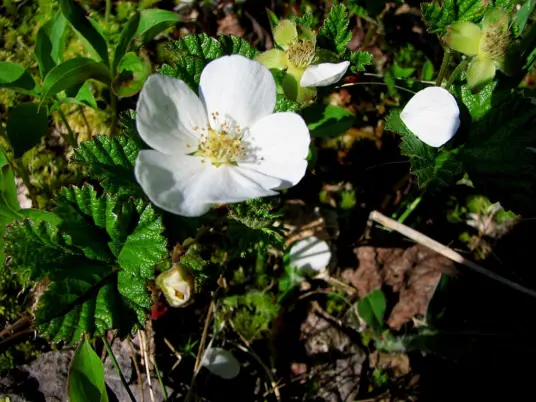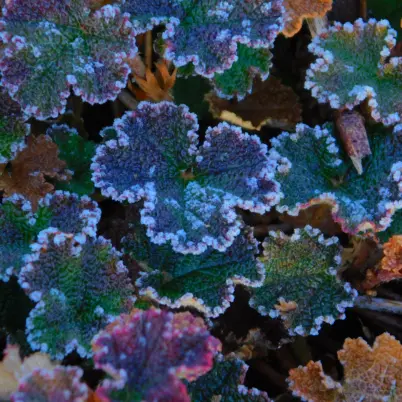Cloudberry: A Rosy Rarity on Campus

Marcia Wilson
At Lakewood Campus thrives one of the rarest culinary berries on the world market. In Canada it is called the Bakeapple; in Finland, Lakka and Hilla (also girl’s names). The English call it Knotberry, the Inupiat the aqpit, and here, the Ground Salmonberry, or, Cloudberry.
Cloudberry as a name is poetic to a fault, but it comes from a very old English word for “hill,” which is also the knot part of knotberry. Cloudberries are a type of thornless raspberry, a member of the Rose family in botany and grow as low to the ground as our native coastal strawberries. They barely top more than a few inches at their tallest. They need the cold, higher elevations with acidic peat or boglands where the soil is low in nutrients. Cloudberries support long, thick carpets of dark green leaves with delicate white blossoms. A cloudberry landscape is an impressive sight. In the fall their blue-green foliage turns into a palette of gorgeous orange, rust, ochre, red and gold. In bloom the small white blossoms shine like stars in a field, and when fruiting the small berries glow a golden orange like tiny lamps.

Cloudberry Carpets
Cloudberries are a champion groundcover in the South Puget Sound, where noxious ivy and blackberries are the bane of the average homeowner. Once encouraged, they will grow so thickly that few other plants can fight through their layers of leaf and runner. This was the incentive for planting cloudberries along the Hageness Driveway on the Steilacoom Blvd side of campus. It took a few years to establish, but now the cloudberries are healthy and dense.
Picking up a single leaf and crushing it is an interesting experience. The leaves have a hard, plastic-like texture with tough ribs and fractal channels. It is designed to toss off the water it does not need. This is one of the more interesting adaptations for bog life; despite the plentiful supply of water, bogs are too cold for ordinary plant roots to thrive. In this respect they are more like desert than oasis.
Now that the weather is at its wettest, cloudberries are extra-impressive. Even with the leaf loss of winter and empty of its pretty berries and blossoms, the plants are still capable of blocking the impacts of heavy rainfall. Cloudberries save landowners a lot of money; they prevent property damage from erosion. Nurseries are catching on to the appealing properties of a groundcover that never grows tall and protects the ground; they may not grow as fast as ivy, but neither will they swallow up the yard.
Cloudberry Cuisine and Culture

Photo Marcia Wilson. The native salmonberry looks very much like cloudberry, but grows on tall shrubs in the rainforest
This member of the Rose Family is lovingly embraced by the culture of humans in its natural range, which has shrunk a great deal since the glacial retreat, and destruction of habitat by humans. The Pacific Northwest climate has witnessed these changes, but wild cloudberries can still be found from Alaska through Washington State. Dan Mallahan, the executive chef of Seattle’s famous Rider Restaurant, was delighted to share his discovery of the berries in places like Mt Baker and Mt Pilchuck.
The leaves are used in folk medicines and drinks. The berries taste like golden raspberries but are much softer and less hairy. Anyone lucky enough to taste a ripe cloudberry is unlikely to forget the burst of flavor on the tongue. Ex-pats living outside a cloudberry range pay high prices to get preserves or extract because the ripe fruit is too soft to travel well. It is so delicate that it crushes itself under its own weight, and that forces berry pickers to use small pails. Even harder to find is the cloudberry honey. Customers rarely complain about the money; cloudberry harvest comes only once a year for a few weeks, and that is assuming the growing conditions were met.
Expensive, yet Valuable.

Cloudberry’s value to humans may be incalculable as medicine, food, and habitat for vital game animals. The Vikings carefully harvested and preserved cloudberries for their sea voyages. They may not have known about Vitamin C, but they knew an absence of this fruit led to scurvy abroad. Cloudberries pack a punch in nutrition, which is another reason why it has stayed so popular when the world market has opened so many dietary choices. 100 grams of fresh cloudberry has 158 mgs of vitamin C; that’s more than three times the same amount of a fresh orange. There’s also the fact that cloudberries grow where the oranges cannot! In Alaska the Inupiat made a rich, nourishing dish out of whipped fat and the berries, called aqpik. This was more than a survival food. It was a satisfying meal with fish or caviar and culturally significant.
“Cloudberry is a golden berry that grows in Estonian wetlands and is difficult to cultivate. It’s also very tedious to pick, as the berries are not conveniently located on compact bushes like blueberries, for example. This makes it very pricey for a jam, but perfection cannot be cheap anyway.”–T. B. KOTINUKA, Life in a Cold Climate
Rare May Always be Rare
Cloudberries will never flood the market, no matter how much they are loved. A single female plant may take seven years to mature enough to produce flowers. They also need male plants to pollinate. One reason why the cloudberries of the UK are so rare is that most of the vines are male. Buying plants is a guessing game as there is no way to tell the females from the males until they are mature. Also, only one berry can be produced on each stem. Weather events are another concern for foragers; the boreal regions are full of surprises. A heavy frost can hit at peak bloom time.
Today with modern advantages, the demand for the fruit always outstrips production and strict laws are in place throughout the northern countries to prevent the destruction of overharvesting. Fruiting or not, they are still a lovely sight on campus.